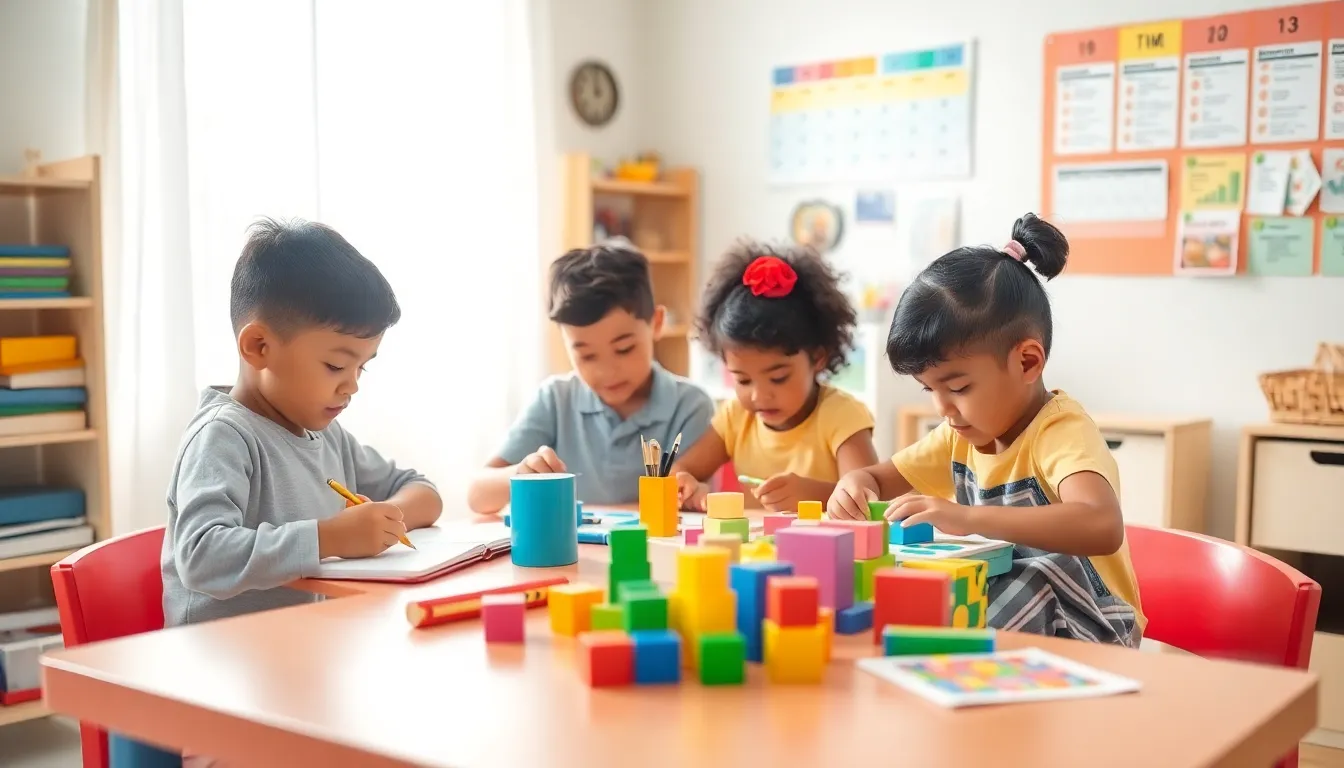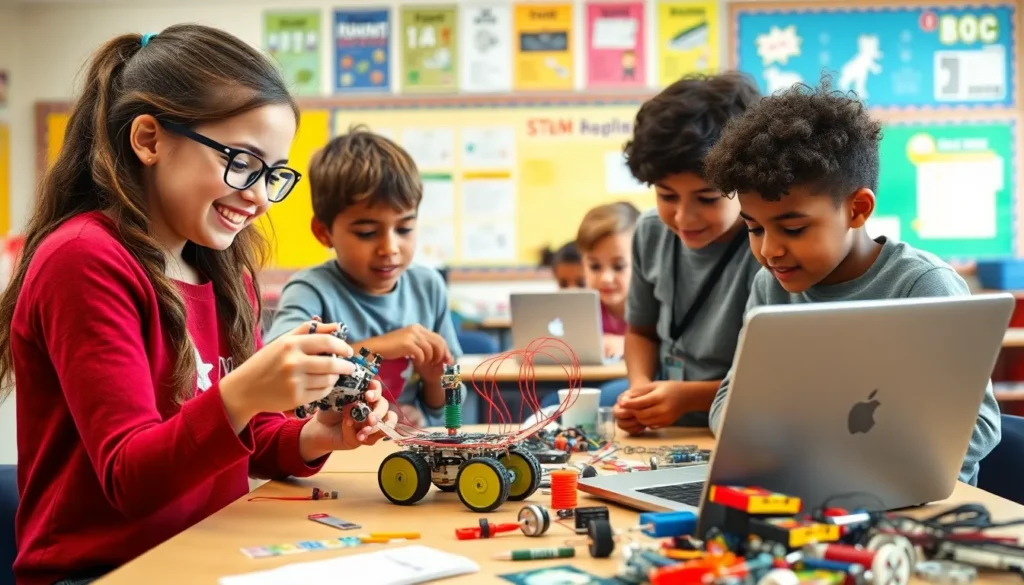Table of Contents
ToggleIn a world where alarm clocks and school bells dictate the day, homeschooling offers a refreshing twist on the traditional routine. Imagine trading in the morning rush for a leisurely breakfast at the kitchen table while diving into the wonders of math and science. With a homeschool routine, the possibilities are endless, and the flexibility is downright exhilarating.
Importance Of A Homeschool Routine
Establishing a homeschool routine provides structure and focus in the learning environment. It promotes consistency, helping students feel secure and aware of their daily tasks. With a clear routine, families can allocate specific times for subjects, ensuring coverage of essential topics.
Creating daily schedules enhances time management skills. Children learn to balance academic responsibilities with free time, promoting a healthy lifestyle. Prioritizing educational activities strengthens knowledge retention. Engaging in a structured environment boosts productivity and motivation, reducing distractions.
Flexibility within a routine allows for adjustments based on family needs. Families can adapt to individual learning styles and interests while maintaining a coherent framework. This balance between structure and flexibility supports personalized education.
Incorporating breaks into the routine facilitates mental rejuvenation. Short pauses during lessons improve focus and prevent burnout. Thus, break time enhances learning efficiency, making room for activities that spark curiosity.
Including a variety of subjects in a homeschool routine fosters holistic development. Exposure to different fields such as arts, sciences, and physical education encourages well-rounded growth. A diverse curriculum builds critical thinking skills and creativity.
Consistency in a routine also fosters accountability. Children understand expectations, making them take ownership of their education. This responsibility cultivates independence and decision-making skills, vital for future success.
Ultimately, a well-defined homeschool routine streamlines daily activities. It provides a roadmap for academic achievements while allowing families to enjoy quality time together. Reinforcing the importance of structure helps families create a fulfilling and enriching learning experience.
Key Components Of A Homeschool Routine

Establishing a homeschool routine involves key components that support effective learning. These elements contribute to a well-rounded educational experience while allowing for flexibility.
Daily Schedule
A daily schedule outlines the time allocated for each subject and activity. Parents can choose specific time blocks that align with their child’s peak focus periods. Engaging in morning sessions can enhance productivity. Afternoon slots may cater to more relaxed subjects or creative activities. Including breaks within the schedule fosters mental rejuvenation and allows for physical activity. Regular mealtimes matter as well, ensuring students have necessary nutrition for optimal learning. Creating a visual timetable helps children understand time management and sets clear expectations for daily tasks.
Subject Allocation
Subject allocation involves distributing hours effectively among various educational topics. Prioritizing core subjects like math, science, and language arts ensures foundational knowledge is strong. Parents can introduce electives based on their child’s interests, such as art, music, or coding. Balancing subject focus provides a comprehensive learning experience. Adjusting the allocation based on progress allows for personalized pacing. Incorporating hands-on projects or experiential learning can reinforce lessons, making them memorable. Reviewing the curriculum regularly helps maintain adaptability and addresses any gaps in understanding.
Creating A Flexible Homeschool Routine
A flexible homeschool routine accommodates individual learning styles and interests, ensuring an engaging environment. Tailoring the approach to each child’s unique needs enhances motivation and retention.
Adapting To Learning Styles
Identifying and embracing distinct learning styles can significantly improve academic performance. Visual learners might benefit from diagrams and videos, while auditory learners engage more with discussions. Kinesthetic learners thrive through hands-on activities, making science experiments or crafting relevant. Observing responses to various teaching methods helps families adapt their approaches. Adjusting materials and resources can create a deeper connection to subjects, fostering a love for learning. Incorporating interest-led projects provides opportunities for exploration and creativity.
Incorporating Breaks
Incorporating breaks promotes mental rejuvenation and enhances overall focus. Scheduling short breaks after intense study sessions allows children to recharge. Engaging in physical activities or mindfulness exercises during breaks can help improve concentration. Each family can customize the length and frequency of breaks based on their children’s needs. Regular intervals prevent fatigue and encourage effective learning. Structuring the day with breaks also offers time for reflection, helping children internalize what they’ve learned. Prioritizing breaks in a homeschool routine ultimately enriches the learning experience.
Tools And Resources For Homeschooling
Effective homeschooling requires the right tools and resources. They help parents streamline the learning process while enhancing engagement.
Curriculum Options
Various curriculum options cater to diverse learning styles. Standard curricula provide structured pathways with clear objectives. Montessori-inspired programs allow children to learn at their own pace while focusing on hands-on activities. Online resources offer flexibility, enabling families to mix and match subjects based on interests. Standardized tests can help assess knowledge and ensure educational standards are met. Homeschool co-ops support collaborative learning, allowing students to benefit from group classes in subjects like art and science. These diversified options empower families to customize education according to individual strengths.
Organizational Tools
Organizational tools play a crucial role in maintaining a well-structured homeschool routine. Planners facilitate daily scheduling and help allocate time for various subjects. Digital apps enable easy tracking of assignments, deadlines, and learning milestones. Charts offer visual reminders of daily tasks, promoting accountability. Binders can store important resources, ensuring materials are accessible and well-organized. Utilizing a whiteboard fosters collaboration and interaction during lessons. Assessing progress through checklists supports goal-setting and keeps learners motivated. These organizational strategies contribute significantly to a cohesive homeschooling experience.
Tips For Staying Consistent
Staying consistent in a homeschool routine requires intentional strategies. Establishing a daily schedule maintains structure and ensures coverage of essential subjects. Allocating specific time slots for each subject enables children to anticipate their activities, promoting security within the routine.
Integrating breaks throughout the day preserves mental sharpness and encourages focus. Regularity in mealtimes helps provide stability, ensuring students remain energized and ready to learn. Incorporating hands-on projects into the schedule enhances engagement, fostering a deeper understanding of topics.
Customizing lesson plans based on each child’s learning style improves retention. Some students thrive in visual environments, while others may benefit from auditory or kinesthetic approaches. Adapting teaching methods to these preferences promotes effective learning.
Utilizing resources and tools, such as planners, keeps families organized and on track. Digital apps can simplify scheduling while offering progress tracking capabilities. Reviewing the curriculum regularly maintains flexibility, allowing adjustments based on learning gaps or evolving interests.
Setting specific goals for each week supports accountability. Children feel empowered when they understand what they need to accomplish. Communicating these expectations clearly helps foster responsibility and independence.
Monitoring progress through consistent assessments identifies areas needing improvement. Frequent reviews help stay aligned with educational standards while adapting teaching approaches. Developing a supportive learning environment encourages children to take ownership of their education, leading to greater success.
Creating an effective homeschool routine is key to fostering a productive learning environment. By establishing a flexible yet structured daily schedule, families can cater to individual learning styles and interests while ensuring essential subjects are covered. Incorporating regular breaks and mealtimes not only enhances focus but also promotes overall well-being.
Utilizing various resources and tools can streamline the homeschooling process, making it easier to track progress and adapt as needed. With intentional strategies in place, families can cultivate a cohesive and engaging educational experience that empowers children to thrive academically and personally. Embracing the unique aspects of homeschooling can lead to a fulfilling journey of discovery and growth for both students and parents.







